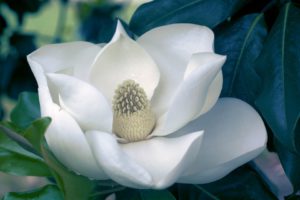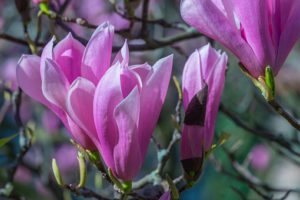Getting your Magnolia Tree to Bloom

The beautiful flower blooms of magnolias are so stunning, these trees will bring that much need flavor to your gardens and landscapes brightening your day. Magnolia Grandiflora also known as bull bay or Southern magnolia belongs to the family Magnoliaceae and is native to Southeastern North Carolina to Central Florida and West to East Texas. There are 12 common species of Magnolia trees and Shrubs.
However, the magnolia trees that are broadleaf evergreens can reach heights of 20-25 ft, others can grow as tall as 80 ft, magnolia trees are showy and can be used as a stand-alone or specimen plant. The magnolia is not fussy at all meaning that it’s a low maintenance tree, each species has its preferred zone so before purchasing and installing ensure that the choice of your magnolia can thrive in your zone.
As beautiful as the flower bloom what do you do if your magnolia tree fails to bloom? this has been the issue and challenge of many persons, in this article however we will be addressing these issues so that your magnolia tree will produce elegant flowers in abundance.
Affiliate Disclaimer
As the owner of this website, I’ve tracked down special deals for some of the products mentioned here. When you use the links on this page to make a purchase I may get a small commission and you will get a great bargain. It’s a WIN-WIN for both of us.
1. Location, Location, Location
Location is so important when it comes to garden plant species, plant species have different light requirements and if that requirement is not met will cause issues to arise and so is the case when installing magnolias. Magnolias thrive in full sunlight to light shade, when growing magnolias in heavily shaded areas will produce little to no flowers.
2. Fertilizers
Fertilizers are plant nutrients and will help in giving garden plants a boost which is beneficial for a plant’s health but the wrong use or overfertilizing can cause serious issues. For example, if you over-fertilize a plant salts from that fertilizer (synthetic quick release) will gather around the plant’s root zone and instead of the roots taking up water, water will be pulled out and away from the root zone causing wilt.
Magnolias are no different fertilizing these plants too heavily will produce fewer- blooms. Nitrogen which is a major element is responsible for leaf growth along with encouraging green-up. Phosphorous promotes a good root system along with flower production if magnolias are being fed more nitrogen than what’s required will give more green and fewer flower bloom.
3. The planting zone
Each species of magnolia thrives best in its zone (zone hardiness ) if you are growing your magnolia in the wrong zone will influence how it produces flowers. Ensure the zone hardiness before seeking to grow one of these trees.
4. The wrong soil type
The soil type may be another reason why your magnolia fails to bloom, most magnolias grow best in soils that are slightly acidic well-drained, and moist. They can also thrive in soils that are slightly alkaline to neutral, magnolias can also survive in soils that are sandy, loamy, or clay but soils that have poor drainage, wet and soggy will affect magnolia’s flower bloom.
5. Watering methods for magnolias
Water plays a major role in the health and survival of garden plants, even low maintenance plants though can survive on little water needs water in order to survive no matter how small the amount. Many garden plants have suffered either because of over or underwatering. Incorrect watering can affect how your magnolias bloom. Technically when it comes to magnolias giving them a good drink of water 2-3 times a week will keep them growing healthy.
6. Pruning
Pruning benefits garden plants and trees in so many ways but if pruning is done incorrectly can cause more harm than good therefore having knowledge when it comes to this procedure is so important. Pruning late in the summer after the last bloom has proven to be beneficial, never prune flowering plants during the growing season when they are growing actively because the removal of flower buds will cause the tree not to bloom or have very little blossom.
7. Root damage

A plant’s root is what the heart is to humans if you damage the roots you will have serious issues, damage roots such as the feeder roots which are responsible for the uptake of water and nutrients will hinder a plant’s normal process of water and nutrients absorption which will lead to the decline of flower bloom. Cultivating the area within the tree roots zone can bring about this issue, caution should be taken when working close to the root zone.
8. Root Rot
Overwatering is one of the major causes of root rot especially with container-grown plants, overwatering will encourage disease that will affect the plant’s roots making them unable to absorb water or nutrients. Ensure that the soil is not waterlogged, give soil acquitted time to dry before reapplying water. Follow the procedure on watering methods as stated above.
9. Frost
Some species of magnolias such as star magnolias, Kobus magnolias, etc.. because of early blooming can suffer from cold damage. Signs of cold damage include brown flower buds, blacken stems, wilting, blackening of leaves, and broken branches. Wait until the weather warms up to do a thorough inspection. Remove damaged plant parts, apply about a 2-3 inch layer of mulch to protect that plant’s roots, and applying a light fertilizer will help your magnolia to bounce back.
10 Heavy winds
Under hash windy conditions flower blooms even the buds can be removed from magnolias because this has to do with the climate there is very little that can be done. The good news, however, is that once the weather clears magnolias can always rebloom.
11. Garden insect pests
Another issue with garden plants is insect pests which cause server damage, knowing how to identify along with the lifecycle of these pests will help to bring control. The main pest problem of magnolias is thrips, scales, aphids, and caterpillars these garden insect pests will suck magnolias sap or fluids causing wilting and discoloration of leaves followed by leaf drop.
Biological control can be carried out by releasing beneficial insects around your magnolia trees such as lacewings, ladybugs, and parasitic wasp. To control by chemicals the use of neem oils, horticultural oil, or Bt bacillus thuringiensis. Bt is very effective and will eliminate caterpillars.
Some species of magnolias
1. Sweetbay magnolias.
2. Arise magnolias.
3. Southern magnolias.
4. Star magnolias.
5. Magnolia Mexicana.
6. Magnolia Officinalis.
7. Magnolia dealbata.
8. Yulan magnolia.
9. Magnolia coco.
10. Magnolia cathcartii.
11. Magnolia ashei.
12. Magnolia acuminata.
13. Magnolia figo.
14. Magnolia poasana.
15. Magnolia guatemalensis.
15 Magnolia fun facts
1. Its believe that most magnolia species can last a century-long.
2. Magnolias belong to the family Magnoliaceae which is over a hundred flowering plants.
3. In traditional Japanese and Chinese practice, the barks and the buds of magnolia have been used for medicine.
4. Magnolias produce a con-like fruit that attracts songbirds.
5. When the Southern magnolia is actively growing it produces a nice lemon fragrance.
6. The magnolia tree can either be deciduous or evergreen.
7. It’s believed that the magnolia tree produces the largest flower that is 14 inches across.
8. Magnolia is named after the French botanist Pierre Magnol.
9. Magnolias are resistant to most diseases and pests.
10. The flowers of the magnolia species come in different colors.
11. The nickname for Mississippi is Magnolia state.
12. The flower of the magnolia comes in many shapes and sizes depending on the species.
13. The wood of the magnolia tree is used to produce furniture.
14. The flowers of the magnolia produce a sugary scent that attracts pollinators.
15. The main pollinators of the magnolia trees are bees.
The final word on Magnolia tree will not bloom
Magnolias are pretty amazing, these trees are so popular and have made a name for themselves which are a favorite. These garden beauties will go to work for you blooming their best. Going down this list that we have discussed and ensuring that each one is implemented will give you much success as your magnolias burst with beautiful colorful flower bloom. If your tree is producing few flowers or no flowers at all don’t despair because you have found the solution just implement these steps and you will be on your way to success as your magnolias thrive with an abundance of flowers.
About the author
Norman loves being in the garden, both at home and for his job....
he is 'Natures Little helper' being outdoors, growing his vegetables and flowers from an early age.
Now having spent over 22 years in the profession he want to give some of his knowledge to others...
his vast array of hints and tips you will find scattered over this site will help you no end growing plants in your garden.

Hello Norman. i live in Central Europe, and the only problem with my magnolia tree is when snow comes late in March. The flowers then turn brown. We have sandy soil, and it seems good for the magnolia. Thank you for the tip about pruning, as I’m not sure how to do it properly. The tree is about 6m high and my husband usually cuts the branches that are too close to the window, as it blocks the sunlight.
Regards,
Debora
I am so happy to help and it is good to know you are having much success with your Magnolia, all the best to you.
Wow,
I have an entire garden in my backyard, I wonder if some of these tips apply. I wonder if I can grow magnolias now, I am bookmarking this and will attempt it.
Also, I had a question about watering. Does it matter what time of the day you water plants. I heard a rumour that if you water your plants in the blazing sun, they can get burned or something.
The best time to water is during the early morning hours to give the soil the time to dry and during this time of the day the water is cool in the ground. Watering in the heat of the day can scold the roots of plants. Watering too late in the even can lead to fungus and roots. I hope this helps.